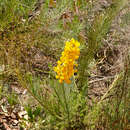en
names in breadcrumbs


Lebeckia is a genus of plants in the family Fabaceae native to the fynbos (Cape Floristic Kingdom) of South Africa. Several members of Lebeckia were recently transferred to other genera (Calobota and Wiborgiella).[1][2] Members of Lebeckia are known to produce pyrrolizidine alkaloids, including ammodendrine, lebeckianine, and lupanine.[3][4] The genus was named by Carl Thunberg for his student Heinrich Julius Lebeck.
Lebeckia comprises the following species:[2][5][6][7][8][9]
The validity of the following binomials has not been established:[10]
Lebeckia is a genus of plants in the family Fabaceae native to the fynbos (Cape Floristic Kingdom) of South Africa. Several members of Lebeckia were recently transferred to other genera (Calobota and Wiborgiella). Members of Lebeckia are known to produce pyrrolizidine alkaloids, including ammodendrine, lebeckianine, and lupanine. The genus was named by Carl Thunberg for his student Heinrich Julius Lebeck.